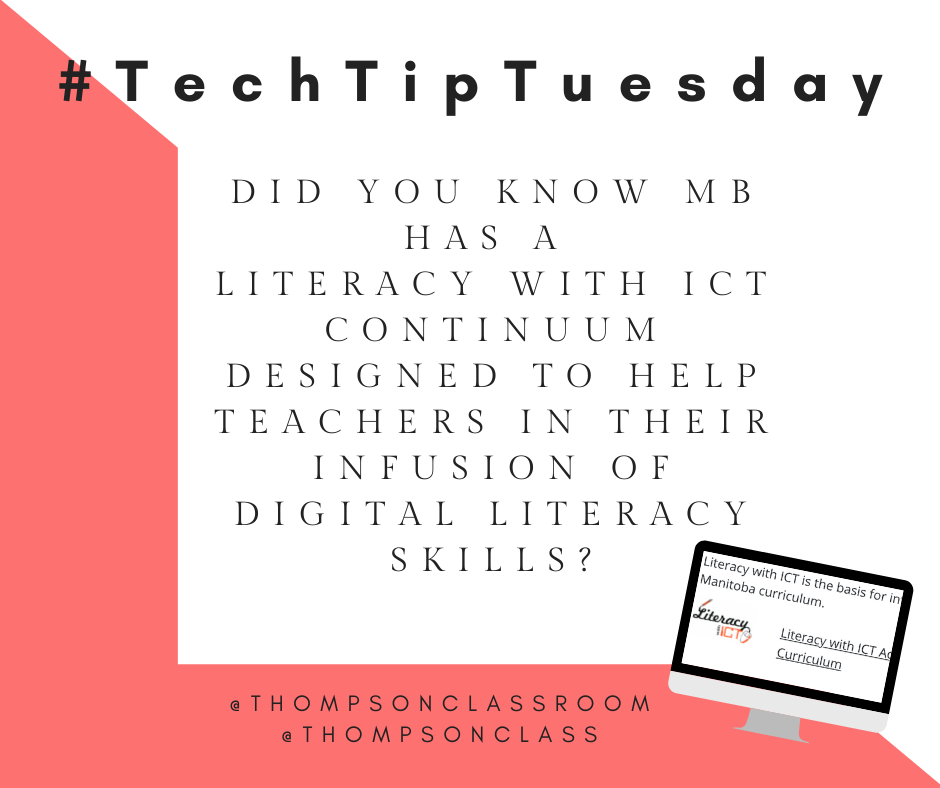#TechTipTuesday – Literacy with ICT

Every Tuesday I share a Tech Tip on our social media pages to assist our staff in their use of technology as it relates to their role.
Technology, like anything, is multi-facited and we naturally become more fluent and comfortable with the aspects that we use regularly. However, the research shows us that the relationship that many students have with technology is one centred on entertainment and communication (Wang et al., 2014, p. 656). Without experience using technology for education we cannot expect our students to seemlessly transition to online learning without guidance and support from us. If you feel that you need to purposefully infuse digital literacy skills with more frequency in the future then I highly recommend you check out our Manitoba Literacy with ICT (LwICT) continuum.
If you are looking for more information about digital literacy, the role it plays in our society, and the integration of these skills in schools please view any of the following posts I’ve made over the years:
– Digital Literacy and the ICT Curriculum
– Philosophical & Cognitive Foundations of an ICT Curriculum
– Challenges in Developing Student Digital Literacy Skills
– Digital Literacies Chapter Review
– Building Your Digital Literacy Tickle Trunk
– The Four Critical Digital Skills We Are Failing to Teach Our Students
– Digital Literacy/Citizenship Skills That Students Need to Have
 |
| Literacy with ICT. (2020). Uploaded by Kirsten Thompson. Available online at: http://fishbowlteaching.blogspot.com/ |
Yesterday I encouraged our staff to purposefully carve out some time to reflect on their experience using online learning platforms. One thing that I am confident that will be brought up in many conversations is the fact that there is a disconnect between what educators assumed students would know how to use when it came to technology and what they actually knew.
Technology, like anything, is multi-facited and we naturally become more fluent and comfortable with the aspects that we use regularly. However, the research shows us that the relationship that many students have with technology is one centred on entertainment and communication (Wang et al., 2014, p. 656). Without experience using technology for education we cannot expect our students to seemlessly transition to online learning without guidance and support from us. If you feel that you need to purposefully infuse digital literacy skills with more frequency in the future then I highly recommend you check out our Manitoba Literacy with ICT (LwICT) continuum.
This is something I have wrote about extensively in the past,
“In Manitoba, the implementation of ICT content, including digital literacy, is outlined in the provincial document A Continuum Model for Literacy With ICT Across the Curriculum, which features a “holistic and pedagogy-focused approach” to ICT integration (Hoechsmann & DeWaard, 2015, p. 15). This document can assist school teams and individual teachers in their planning of grade/age-appropriate ICT tasks, how to include both literacy and citizenship aspects, and how to assess where students are developmentally. It not only identifies that students require a different set of literacies to thrive in the digital world, but also that students need to prepare to adapt to the ideas, attitudes and technologies that are ever-changing in the digital world (Manitoba Education, Citizenship and Youth, 2006, p. 7). In Manitoba, the incorporation of ICT elements has helped students learn at their own pace, assisted students who do not have access to at-home supports, allowed for more one-on-one time with teaching staff, and allowed parents to stay more involved in their child’s learning (Stephenson, 2013, p. 11). It is important to note that Manitoba does not have a separate curriculum dedicated to ICT but that it sees these skills as harmonious elements that need to be infused alongside pre-existing concepts (Manitoba Education, Citizenship and Youth, 2006, p. 9). As such, it is supported by seven guiding principles: (1) inquiry-based learning, (2) constructivist approach to implementation, (3) high-level critical thinking, (4) deep understanding of concepts, (5) gradual release of responsibility, (6) digital citizenship, and (7) multiple literacies (Manitoba Education, Citizenship and Youth, 2006, p. 11). By outlining ICT implementation as a continuum, Manitoba easily assists teachers in identifying students’ understanding and begin incorporation in a manner that suits their teaching style and comfort levels.”
I have also highlighted some of the features of this resource in our Instagram and Facebook stories today!
If you are looking for more information about digital literacy, the role it plays in our society, and the integration of these skills in schools please view any of the following posts I’ve made over the years:
– Digital Literacy and the ICT Curriculum
– Philosophical & Cognitive Foundations of an ICT Curriculum
– Challenges in Developing Student Digital Literacy Skills
– Digital Literacies Chapter Review
– Building Your Digital Literacy Tickle Trunk
– The Four Critical Digital Skills We Are Failing to Teach Our Students
– Digital Literacy/Citizenship Skills That Students Need to Have